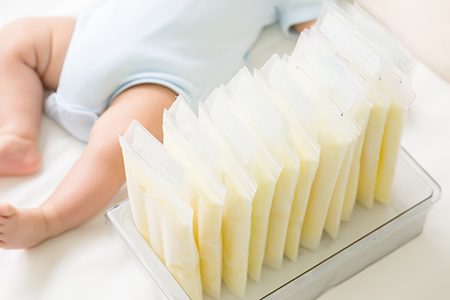
If you're planning to breastfeed when your baby is born, you want to be as prepared as possible. In addition to breastfeeding positions and how to get a good latch, one important topic to learn more about is pumping breast milk.
While some moms only pump breast milk occasionally, others may choose to use pumping as the main way to feed their new baby. No matter what you choose, getting to know the basics of pumping ahead of time can help you be more successful.
Choosing a breast pump
When it comes to breast pumps, you have many options. The right choice for you often depends on how often and where you plan to pump.
First, if you have health insurance, check with your plan to see what types of breast pumps are covered and the process for ordering one before your due date. According to HealthCare.gov, most insurances are required to cover the cost of a breast pump as part of your plan. However, they may only cover certain types and brands of pumps.
Types of breast pumps to consider include:
- Manual pumps - With this type of pump, you manually squeeze a lever to create suction and pump milk. Most manual pumps allow you to pump one breast at a time, so they are best suited for only occasional use.
- Hospital-grade pumps - Most pumps you buy are meant to be used only by one person. But hospitals or other medical supply providers sometimes offer pumps for rent that are designed for multiple users.
- Electric and battery-operated pumps - These pumps usually allow you to pump both breasts at once and use electricity to create suction. Some pumps require you to plug into an electric outlet to pump. Others may have a rechargeable battery so that you can use your pump without an outlet nearby.
- Wearable pumps - Wearable pumps are designed to fit inside of your bra so that pumping is more discreet, and you don't have to hold them while you pump. They can be appealing to new moms who need to pump at work or on the go, but can often be the most expensive option.
One other factor to consider in choosing a pump is breast shield sizing. There are different sizes of breast shields, and you want to make sure the pump you choose has a breast shield size option that fits you comfortably.
Caring for your breast pump
It's important to clean your breast pump parts every time you use your pump. This helps prevent germs from growing on your pump parts and potentially coming into contact with your breast milk. Careful cleaning is especially important for premature or other immune-compromised infants.
Some tips from the FDA to keep your pump clean include:
- Wash all of your pump parts that come into contact with milk with warm water and soap and allow them to air dry.
- Avoid using sponges or cloths on your pump parts that you also use on regular dishes.
- Many pump parts are also dishwasher safe on the top rack.
- If you don't have access to a sink to clean pump parts during the day, consider buying extra parts to switch out.
- Microwave sterilizer bags are also acceptable for sanitizing parts.
- Only clean your pump tubing if it comes into contact with breast milk or you see condensation appearing.
Safely storing breast milk
After you pump, you want to make sure you store your breast milk safely. You can leave fresh breast milk at room temperature for a short period of time. Otherwise, you'll want to store it in the refrigerator or freezer.
In general, the guidelines from the CDC for safe storage include:
- Freshly pumped milk can stay at room temperature for up to four hours.
- Freshly pumped milk is safe in the refrigerator for up to four days.
- Frozen milk is best to use within six months, but up to 12 months in typically acceptable.
- Use previously frozen milk that's been thawed in the refrigerator within 24 hours.
- Never refreeze breast milk.
- If your baby doesn't finish a bottle of breast milk, use it within two hours or discard it.
For additional guidance on safely handling breast milk, talk with your healthcare provider. The CDC's frequently asked questions page also offers advice for common milk storage concerns - from what to do if the power goes out to air travel with breast milk.
Finding the right pumping routine for you
If you're away from your baby or choose to pump exclusively, the most important thing is to pump as often as your baby eats. This will help keep up with your baby's demand for milk and maintain your supply. The La Leche League says most moms find pumping every two to three hours keeps their breasts from becoming uncomfortably full.
In the end, both breastfeeding and pumping can come with challenges. But by making a plan and finding support through a local breastfeeding or lactation consultant, you'll be more prepared to address any concerns as you get started. With the right support, you'll find the best pumping routine for you and your baby and be on the way to meeting your pumping goals.
